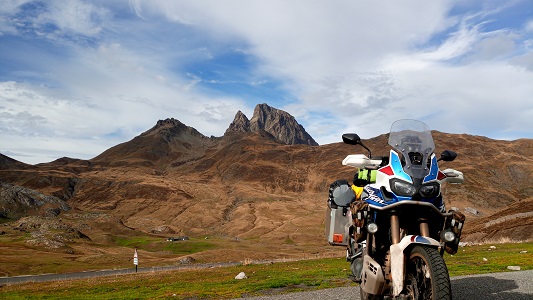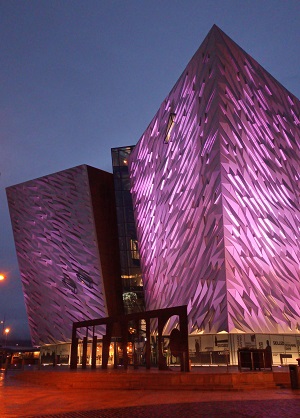 Arrived by ferry in Belfast, the trip went directly to the Youth Hostel. I checked in and made my way to the city center on foot. It was raining a bit and I looked at some of the sights on the way to the Titanic Museum. The most impressive was the Titanic Museum. A very modern building in an old city. At night, the facade is illuminated and the building looks even more impressive.
Arrived by ferry in Belfast, the trip went directly to the Youth Hostel. I checked in and made my way to the city center on foot. It was raining a bit and I looked at some of the sights on the way to the Titanic Museum. The most impressive was the Titanic Museum. A very modern building in an old city. At night, the facade is illuminated and the building looks even more impressive.
The next day I booked a guided bus tour along the coast to the Giant Causeway. The weather was initially cloudy and slightly rainy. But after a short time it cleared up, the sky was blue and the sun was shining. The bus driver kept talking all the time, talking about all the things along the way and the locations of the "Games of Thrones" series. We stopped at a rope bridge, who wanted could cross it for an extra charge. I decided to explore the area and not cross the bridge. As I strolled around I came to the second parking lot, I saw a bulletin board with some pictures of "Games of Thrones", a fight scene was filmed in this lot. You would not think that if the blackboard were not there. What the right perspective in shooting a film can make is remarkable.
The tour continued to the Giant Causeway. The coastline consists of evenly shaped basalt columns. The columns form a path that goes into the sea and, according to a legend, reappears on the Scottish coast.
The legend (source: Wikipedia):
"According to legend, the columns are the remains of a causeway built by a giant. The story goes that the Irish giant Fionn mac Cumhaill (Finn MacCool), from the Fenian Cycle of Gaelic mythology, was challenged to a fight by the Scottish giant Benandonner. Fionn accepted the challenge and built the causeway across the North Channel so that the two giants could meet. In one version of the story, Fionn defeats Benandonner. In another, Fionn hides from Benandonner when he realises that his foe is much bigger than he is. Fionn's wife, Oonagh, disguises Fionn as a baby and tucks him in a cradle. When Benandonner sees the size of the 'baby', he reckons that its father, Fionn, must be a giant among giants. He flees back to Scotland in fright, destroying the causeway behind him so that Fionn would be unable to chase him down. Across the sea, there are identical basalt columns (a part of the same ancient lava flow) at Fingal's Cave on the Scottish isle of Staffa, and it is possible that the story was influenced by this."
After visiting the basalt columns, we went back to Belfast.
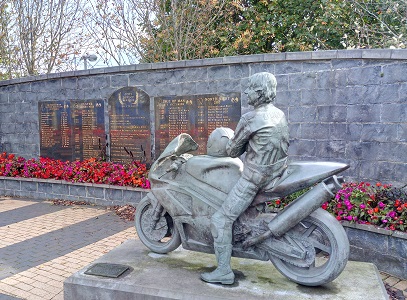 The next day I drove again along the coast. This time with the motorcycle. I took some photos that were not possible on the bus and drove to Ballymoney for the Dunlop Memorial. Almost every motorcyclist knows who Joey and Robert Dunlop were. And if there is a monument and you are in the area, you go there. For those of you who do not know, Joey and Robert Dunlop were two of the most successful road racers. Both were killed in such street races. Joey Dunlop near Tallinn in Estonia and Robert at a road race in Northern Ireland.
The next day I drove again along the coast. This time with the motorcycle. I took some photos that were not possible on the bus and drove to Ballymoney for the Dunlop Memorial. Almost every motorcyclist knows who Joey and Robert Dunlop were. And if there is a monument and you are in the area, you go there. For those of you who do not know, Joey and Robert Dunlop were two of the most successful road racers. Both were killed in such street races. Joey Dunlop near Tallinn in Estonia and Robert at a road race in Northern Ireland.
Then I drove to Derry, which is on the border with Ireland. The city still has the old city wall in almost original condition. When I talked to the host of the B&B I was staying in, she told me that a hurricane was heading towards Ireland and it's probably too dangerous to drive along the coast. I checked the weather on the Internet and, indeed, Hurricane Lorenzo headed straight for the Irish west coast. So I changed my itinerary for the next day and drove first to Malin Head, the northernmost point of Ireland. It was windy, but driving was not a problem. Until I had to drive up the last 50 meters a small hill to Malin Head. The wind was so strong that it almost threw me off the bike. Luckily, a German couple was there to help me park. We talked for a moment and they went on a reconnaissance tour. I set off again. The wind had not subsided and again and again violent gusts of wind came from the side. I waited until a gust was over and quickly drove the 50 meters down the hill.
Malin Head is located in the Republic of Ireland, Derry in Northern Ireland. There are no hard borders between the countries, not even abandoned ones, like you can find in the rest of Europe. The only indication that you are in another country are the speed charts. In Ireland, the tables say "km/h" after the number. Of course, the currency is different, but you only realize that when you go shopping.
As my route had changed because of the hurricane, I drove south inland. Again and again I crossed the border of the two Irish countries. In the evening I arrived in Leitrim Village in a small lodge. The room was cheap and the food too, but really good. There is not much in this village. A couple pubs, a couple hotels, a chinese restaurant, a school and a petrol station. That's it. The internet connection was good and I had to work a bit on my website, so I stayed one day longer. I went for a walk and then sat down to work. The TV was running in the background. Main topic: Brexit. In the evening I ate again in the pub and drank a few beers. Suddenly an Australian spoke to me: "Do you know Toby Price?" I answered with "yes". 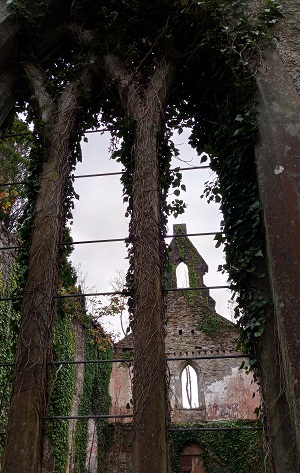 He sat down on my table and told me that Toby Price played football with his son when they were kids, and that he only had motorcycles in his head. Toby Price is a motocross rider and multiple Dakar winner. We talked for a while and the table neighbors started to talk to us. These said that earlier there was a road race passing trough Leitrim and Joey and Robert Dunlop were two of the drivers. At the end of the evening we said goodbye and I talked to a couple from Canada who visited Ireland by car.
He sat down on my table and told me that Toby Price played football with his son when they were kids, and that he only had motorcycles in his head. Toby Price is a motocross rider and multiple Dakar winner. We talked for a while and the table neighbors started to talk to us. These said that earlier there was a road race passing trough Leitrim and Joey and Robert Dunlop were two of the drivers. At the end of the evening we said goodbye and I talked to a couple from Canada who visited Ireland by car.
The next day I drove to Galway. The hurricane had gone by and thankfully did not hit Ireland as hard as expected. In Galway I wanted to buy seaweed, which should be an Irish specialty. It has been raining the whole day. When I arrived in Galway the traffic was halting. I slowed down and lay on the ground. The whole street was full of oil. Rain and oil, a perfect combination for motorcycles. The road went downhill and I made slow progress. Then I lay on the ground again. Both times, people were quickly there to help me get the bike back on the wheels. Otherwise, the column would have become very long behind me. I left the oiled road, parked the motorcycle and asked a passerby where I could buy seaweed. She explained the way to a shop. When I got what I went to Galway for, I drove on to Dublin. I stayed one night in Mountmellick and drove to Dublin the next day. I had been in contact with Gabriel, whom I had met in Tallinn. He offered to leave the motorcycle in his garage. Perfect. I could have stayed also at his place but did not want to bother him too much and stayed in a hostel. Nevertheless, we met several times for a few beers and dinners.
At the same time Mirella was in Dublin with her aunt and attended an English course. It was planned that we would meet, as in my trip 2015/16, on New Year's Eve. But destiniy wanted that we meet in Dublin. We met for dinner and strolled a bit through Temple Bar. Two days later we visited the Leprechaun Museum together. It was a wast of money, but things like that you don't know before.
On my last day in Dublin, I met Tanja. We had breakfast together and visited Dublin in the morning on foot. In the afternoon we took part at a free-walking tour and in the evening we were invited to dinner at Gabriel's place. It was a nice day and it was good to spend a longer time in company again.
My journey continued the next day. I took the ferry to Wales and stayed a few miles from the harbor. It was raining all evening. The next day the rain stopped and I drove over the Pen Y Pass through Snowdonia to Capel Seion, a small village near Aberystwyth. The host, Carl, used to drive a motorcycle himself until a serious accident forced him to quit. Nevertheless, he was still completely crazy about motorcycles. Through him I also joined a welsh motorcycle group on Facebook. The motorcyclists in this group are really different than those in my Swiss group. People are more active and react to posts.
I visited a few dams in Wales and drove on to visit the Tintern Abbey, a monastery ruin where you would of course have to pay admission to see it from the inside. But even without admission you saw enough of it and could take some photos.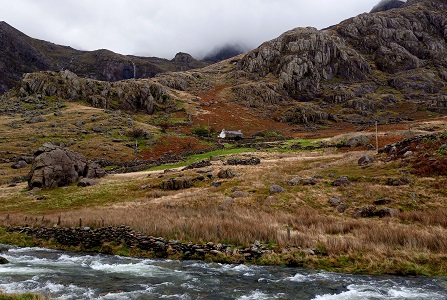 The visit to the dams took much more time than expected, so I looked for a place to stay and finally found something in Ross-on-Wye. London was the destination for the next day. On the way, I made a quick stop in Stow-on-the-Wold to see a door of St. Edward's Church. To the left and right of the door, the trees were so waxed that they became one with the door frame. In London I stayed in a hostel. With the tube I only had half an hour to the city center. The hostel was not right on the street and had a parking lot that was not visible to passers-by. A few weeks later, I was told that this area should be one of the least safe of London. I spent four days in England's capital and met Anschi from my swiss motorcycle group. She was just in London for a language course. Again, I attended a free-walking tour.
The visit to the dams took much more time than expected, so I looked for a place to stay and finally found something in Ross-on-Wye. London was the destination for the next day. On the way, I made a quick stop in Stow-on-the-Wold to see a door of St. Edward's Church. To the left and right of the door, the trees were so waxed that they became one with the door frame. In London I stayed in a hostel. With the tube I only had half an hour to the city center. The hostel was not right on the street and had a parking lot that was not visible to passers-by. A few weeks later, I was told that this area should be one of the least safe of London. I spent four days in England's capital and met Anschi from my swiss motorcycle group. She was just in London for a language course. Again, I attended a free-walking tour.
These free-walking tours are now available in almost every major city that has many tourists. They give you a brief overview of the history and sights of the city. If you do not know which tour to do, these free tours are ideal to help with the decision.
After the days in London I drove to the southwest of England, to Cornwall. On the way I visited Stonehenge. I had received the tip how to visit the stones without paying, which saved me some money. I stayed in a guesthouse near Bodmin and made a day trip to Lizard Point, the southernmost point of the English main island. The view and the coast are wonderful.
The last day in England had started and I met with a school friend of my mother and her son. We, my mother, my sister and I, visited them 20 years ago and I had not seen them since then. It was a nice reunion and I was glad that we could meet. In the evening I drove to Bournemouth to take the ferry to France the next day. The ferry started at 8:30. This already meant to be at the harbor at 7:30. The crossing took five hours and 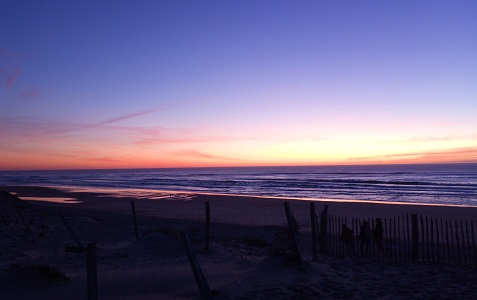 I stayed overnight in Cherbourg. France was more or less a thoroughfare. From Cherbourg I went to Avranches to see Mont-Saint-Michel the next day. The hill is about one kilometer in the Wadden Sea and years you had to pay attention to the tides to get on or off the hill. Meanwhile, there is a jetty that always guarantees access. The hill is dominated by the abbey at the top. On the way up to the abbey you pass numerous souvenir shops and restaurants. Everything in a huge crowd. Mont-Saint-Michel is visited annually by more than two million people. Nevertheless, it is impressive to see what people can build.
I stayed overnight in Cherbourg. France was more or less a thoroughfare. From Cherbourg I went to Avranches to see Mont-Saint-Michel the next day. The hill is about one kilometer in the Wadden Sea and years you had to pay attention to the tides to get on or off the hill. Meanwhile, there is a jetty that always guarantees access. The hill is dominated by the abbey at the top. On the way up to the abbey you pass numerous souvenir shops and restaurants. Everything in a huge crowd. Mont-Saint-Michel is visited annually by more than two million people. Nevertheless, it is impressive to see what people can build.
The next attraction I wanted to see in France was the dune of Pilat. It is the largest sand dune in Europe and two days from Mont-Saint-Michel. I had booked a bed in a dorm in Biscarrosse-Plage. The reception was very friendly. The bike I could put in the yard, so it had not to stay on the road. I visited the dune. A huge, 110 meters high and nearly three kilometers long pile of sand. Already the dune Råbjerg Mile in Denmark was breathtaking. These one even more. Of course, this dune, like all places of this kind was well visited and a photo without other people on it was very difficult to shoot.
The next day I made my way to Spain. I had planned to drive to the border and drive over the Pyrenees the next day. It was Sunday and there was little traffic, by noon I already had the planned route behind me and I decided to drive to Alquézar the same day. So I drove up to the pass of Pourtalet and stopped for some photos. Spain was reached.
